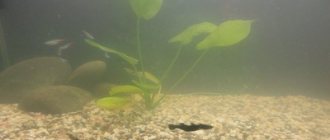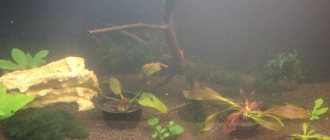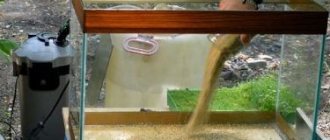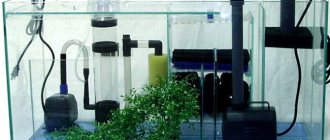In nature, plant leaves absorb carbon dioxide and produce O2 during photosynthesis. In bodies of water, plants produce oxygen for all creatures. But in a confined space it is important to provide the inhabitants with enough oxygen when there are a large number of fish and a small number of underwater plants. In these cases, aeration is used in the aquarium.
What is water aeration
Aeration of water in an aquarium is the process of movement of layers of liquid. Aquarium aeration saturates the aquarium water with oxygen. The movement of liquid begins with the release of small water bubbles from the aeration device. The larger the space of the device, the faster the liquid is saturated with gas.
In lakes and rivers, the aeration process occurs due to waves, currents, winds and the abundance of plants. In an aquarium, plants do this, although they are an unreliable supplier of O2, since they consume oxygen when there is a deficiency of carbon dioxide or in the dark.
Criterias of choice
To choose the best aquarium sprayer, you need to determine what it will be used for. When choosing equipment you need to pay attention to the following points:
- Power. This indicator depends on the size and configuration of the product and is determined by the number of air bubbles emerging from a unit surface area of the device. Power shows how quickly the aquarium will be saturated with oxygen. For large containers, it is recommended to choose long and wide rectangular products.
- The noise made by the device during operation. This aspect is especially important when the aquarium is in the bedroom or nursery. The noise increases if there is no soil in the aquarium and the sprayer is located directly on the glass, or if the amount of soil under the product is insufficient.
- Possibility of disassembling the device for cleaning in case of contamination. Since the device is usually placed at the bottom of the reservoir, over time the holes in it become clogged with silt or soil particles. If the device cannot be disassembled and cleaned from the inside, it must be replaced with a new one.
- Hole size. Aquarium sprayers can have both large and small holes. When choosing a device, you should take into account that sprayers with small bubbles saturate the water with oxygen more effectively.
- Appearance. Pet stores offer a large selection of sprayers of all possible shapes and colors. Thanks to this, you can choose an option that suits any aquarium design.
Is aeration necessary in an aquarium?
There are no fish species that do not need oxygen in the aquarium. There are fish that breathe atmospheric air; they float to the top of the water and swallow it. But most inhabitants need O2.
An aquarium is a living world. It is home to not only human-settled pets in the form of fish and other aquatic organisms, but also aerobic bacteria that live in the soil and in plant thickets. These bacteria are not dangerous. They maintain biological balance. In an aquarium without aeration, the balance is disrupted and the inhabitants cannot exist normally.
In still water, the process of penetration of oxygen particles into the water column is very slow. Oxygen particles penetrate only 2 cm into the water per day. For fish in an aquarium, this is very little. Therefore, water must be independently enriched with O2. This is done using filters, compressors, and sprayers.
Is it necessary with plants?
The plants in the aquarium produce enough O2 to support a small number of fish. But for numerous settlements there must be a lot of plants. At night, plants also consume oxygen, leaving living inhabitants without valuable gas. The best solution would be to purchase aerating devices.
Varieties
There are two types of aquarium sprayers on sale: those made from natural materials and artificial ones. The first ones are made from special porous stones that can allow air to pass through, breaking it into small bubbles. Stone products are environmentally friendly and do not spoil the natural design of the aquarium, but they have one drawback - the noise created during operation. Therefore, aquarists often opt for artificial atomizer options.
Artificial products can have different shapes and are made from various materials (rubber, plastic, etc.). Most often in aquariums, especially large ones, flexible sprayers made of soft rubber with many small holes are used. It is easy to give such products the desired shape and place them in the required place of an artificial reservoir - on the bottom, wall, along joints or decorative elements.
Other types of artificial sprays - disk, ring or in the form of decorations - are used less frequently. Disk products are a flat disk made of porous material, the entire surface area of which releases air bubbles. Ring versions differ from disk ones by the presence of a hole in the middle. Large diameter rings are convenient to place around decorations or plant pots, creating an unusual design using a curtain of air bubbles.
Methods of water aeration
There are two types of water aeration.
Natural
This is growing plants or breeding snails. When plants grow, oxygen is released through photosynthesis.
Snails are an indicator of the amount of gas. When the liquid is depleted of oxygen, they are placed on the leaves of plants or on the walls of the aquarium. If the oxygen level is normal, the snails are placed on the bottom or rocks.
Artificial
This is the use of aeration equipment. Used: compressors and pumps.
Compressor
Compressors spray bubbles into the liquid, which enrich the liquid with O2. They must work in the aquarium continuously.
Is it possible to turn off the compressor?
Aquarium aeration devices must not be switched off. Many new aquarists turn off their water aeration compressors at night because these devices create a lot of noise. This is absolutely impossible to do.
At night, fish especially need aeration, because underwater plants stop releasing O2 and absorb it themselves. Aerating devices must operate continuously and continuously to saturate the water with oxygen.
Sprayers
Air nozzles are part of compressors. With the help of sprayers located in the ground of the aquarium, the air is distributed into bubbles that the compressor pumped from the outside of the aquarium. Air is supplied to the aquarium. Bubbles move layers of water. This helps saturate the liquid with oxygen.
Soil filter
Ground filters for aquariums perform a similar function to a compressor. Filters create currents. This promotes the movement of layers of water. The top layer of water, in contact with air, is saturated with oxygen and sinks to the bottom with the current. When purchasing and installing a ground filter, a compressor is not needed.
Specialized pumps
Water aeration pumps are equipped with a filter device and channels for supplying oxygen to the aquarium. It is purged with air much better than a compressor. The throughput of the pump should be at least one third of the volume of the aquarium.
Hoses and connectors
Hoses and connectors are an additional attribute to the compressor or pump. They are needed to move and rearrange devices. A hose and a sprayer are attached to distribute the bubbles over a larger area throughout the aquarium.
Aeration without electricity
Suitable for transporting fish in the absence of electricity.
Hydrogen peroxide
Hydrogen peroxide is a catalyst that, when released into water, breaks down into oxygen and water. It is completely harmless to underwater inhabitants. Peroxide is used to resuscitate suffocated fish and to destroy harmful algae on plants.
Oxygen tablets
Oxygen tablets are needed to quickly raise the oxygen level in the water. Another purpose is to transport fish in a short time. One oxygen tablet contains 30 mg of oxygen.
Oxidizers
Oxidizers work by adding hydrogen peroxide and a catalyst. A chemical reaction occurs, the result of which is the release of O2. They are used when transporting fish in conditions where there is no electricity or human intervention.
Manual compressor
Hand compressors are used when transporting fish for sale. Such compressors are powered without consuming electricity by pressing hands. The simplest manual compressor can be made from a rubber bladder from a bicycle or ball. Air is forced into the chamber and adjusted by pressing.
Ozonation
Ozonation is another type of aeration. Its peculiarity is that instead of air, ozone molecules enter the water. Ozone consists of O2, so ozonation is effective. Ozonation disinfects aquariums and eliminates turbidity. This is especially important before fish spawning. It is carried out only when there are no creatures in the water.
Advantages of sprayers
Advantages of the first two types of sprayers:
- affordable price;
- Suitable for almost any air pump, even low-power ones.
- they are easy to disguise.
Ceramic atomizers are more efficient, but are more expensive and are suitable for compressors that develop a pressure of at least 1000–1500 mm of water column. Their disadvantages include noise during operation.
Long Tubular Synthetic Atomizers:
- can be easily disguised (attached with suction cups to a smooth surface);
- have an air supply regulator on the hose;
- come in lengths from 20 to 60 cm, which allows you to choose a sprayer for a specific aquarium;
- a long wall of bubbles creates active water movement.
Almost all internal filters are equipped with a built-in sprayer, in which an air hose is attached to the filtered water outlet tube. With the help of this hose, atmospheric air is mixed into the water flow and complete aeration is obtained.
What affects oxygen content
The oxygen content in the aquarium is affected by:
- Temperature. In a liquid with an elevated temperature, the amount of gas is always less than in a liquid with a lower temperature. Elevated temperature is dangerous by accelerating metabolism. With accelerated metabolism, aquatic organisms consume O2 more than usual at the moment when its deficiency is observed.
- Flora of the aquarium. Plants emit O2 in the light, but at night they also consume it.
- Bacteria. Aerobic bacteria living in the soil are beneficial for the microflora of the aquarium. But when there is leftover food or a large amount of waste, the bacteria are activated and actively multiply. A large number of aerobic bacteria will only cause harm, because it will cause a lack of O2.
Useful tips
And finally, a few recommendations.
It is better to place the air sprayer in the center of the aquarium for the purpose of the most measured air exchange. However, in large tanks it is advisable to install 2-3 units in different corners. In addition, it is better to install them near the heater to quickly mix the heating liquid with the total capacity of the aquarium.
It is better not to bury devices in the ground , since this is more likely to cause them to fail; however, for aesthetic purposes, you can bury them in the ground.
Of course, the pores on them close up faster, but this is a consumable that is not really a pity. So to speak, everything is for the sake of beauty.
Once the pores of the sprayer become clogged, it is extremely difficult to clean it. Here's some advice on how to clean it without any problems. You just need to put the sprayer in the bleach solution for 30-40 minutes - and there will be no trace of the brilliant green. Then, upon completion of the soaking operation, the device is thoroughly washed with pipeline water and put back into operation. Or removed as a backup option.
How to check the oxygen level in an aquarium
Oxygen in an aquarium is checked with devices and tests for determining O2 levels, which are sold in pet stores.
Main functions
Without exception, all modern faucets contain a diffuser. In addition to significant water savings, the device is capable of:
- significantly improve the quality of the jet - the spray will not fly in different directions. Without it, the pressure is too high, and it is difficult to adjust it to your needs;
- saturate the water with oxygen and significantly reduce the concentration of active chlorine, which negatively affects the human body.
The aerator allows you to reduce the noise level when the mixer is operating.
DIY aeration
Pet stores sell a variety of devices that can purify the air. But there is an option to do aeration in the aquarium with your own hands.
To make a compressor for an aquarium with your own hands, you will have to purchase a power supply and a motor.
What you will need:
- Power unit.
- A small motor (for example, from a printer).
- Plastic cover.
- Candles.
- Rubber tube.
- Adapter.
- Balloon.
- A wooden stick (for example, from a lollipop).
- Hot glue stick.
- Several wooden blocks.
- Plywood.
- Wire.
- An elastic band (for example, from a bicycle inner tube or a ball).
How to make a compressor for aeration with your own hands:
- Cut the balloon in half with scissors.
- Take a plastic cover and drill 2 holes in it (3 and 6 mm) at the same distance. Sand rough edges.
- We cut out a horseshoe shape from elastic band. This will be the valve of the device. The valve is glued with its legs to the inside of the drilled cover. The wide part of the valve should cover the 3mm hole.
- We pull the cut out part of the ball onto the lid. The surface should be elastic, like a small drum. Glue with tape and trim off the excess parts of the ball.
- Cut out a small rectangle from plywood. It must be proportionate to the motor. Glue the motor to the plywood.
- Now let's make the base of the compressor. We take a piece of plywood and 2 bars. We glue the bars to the plywood in the form of legs and supports. We glue the prepared motor with plywood into the corner. At the bottom there is a connector for connecting the power supply.
- We shorten the stick; it should be no more than 8 mm wide. Using an awl, we pierce holes on the top and sides. Insert a piece of wire into the hole on the side. It turned out to be an eccentric. We install it on the motor shaft.
- Shorten the lollipop stick by 4 cm. Glue it to the candlestick. To attach it to the eccentric, drill a hole on the side of the stick and attach it. Attach the other end of the stick with glue to the center of the lid with the ball. Glue the cover onto the plywood.
- Cut a 6 mm hole in the lid with the ball. Fix the adapter into the hole and attach the rubber tube.
The aerator is ready for use.
Is there a difference in the appearance of foam in the new and old tank?
The difference in the appearance of foam in an old and new aquarium depends on the nature of its origin.
If the origin is chemical (feed, toxic decorations, medications, algaecides), then there will be no difference.
If the foam is of a biological nature (problems with the filter, loss of biological balance, bacterial outbreaks), then older aquariums are more resistant to such phenomena, since they have a supply of beneficial bacteria and a fully running nitrogen cycle.
In them, foam forms noticeably less often, and if something happens, it passes noticeably faster. The exception is soil acidification. Only old aquariums are susceptible to this phenomenon.
Errors
Aeration maintains stable gas exchange of water and destroys films on the surface of the liquid. Therefore, a tank equipped with an aeration system will be a reliable and safe home for underwater inhabitants.
Previous
AquariumGrotto for an aquarium with your own hands: from stones, what to make it from, from coconut, tracing paper, wood, clay, glass bottle, purchase (ship)
Next
AquariumAquarium for beginners (aquarium science): care, maintenance, what you need at home, how to choose, rules for a beginner, tips
Great article 0











